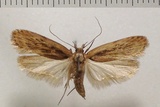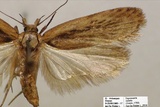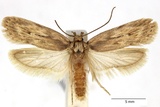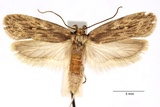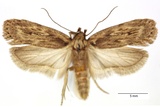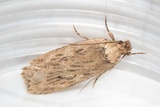Depressaria radiella (Goeze, 1783) Species
Last modified: Nov. 29, 2024, 1:50 p.m.
A rare species throughout Belgium, but easily overlooked.
Details
- Classification
- Family: Depressariidae > Subfamily: Depressariinae > Genus: Depressaria > Species: Depressaria radiella
- Vernacular names
- Groot platlijfje (NL)
- Synonyms
- Depressaria heraclei (Retzius, 1783) , Depressaria pastinacella (Duponchel, 1838) and Depressaria heracliana sensu auct., nec (Linnaeus, 1758)
- First mention in Belgium
- De Sélys-Longchamps E. 1844. Énumération des insectes Lépidoptères de la Belgique. — Mémoires de la Société royale des Sciences de Liége 2: 1–35. On page 24 (as Haemilis pastinacella Zeller). view page
- Status
-
Native
Distribution
Caterpillar
Greyish; head capsule, prothoracic plate, thoracic legs and last abdominal segment black
Cocoon/pupa
Not a real cocoon, just some loose spinning of silk. Pupa brown.
Bionomics
The egg is oviposited on the shoot or developing flowers.
Later instars feed on the flowers and seeds where they construct tough silken galleries from which they feed. In some circumstances, especially when more than one caterpillar is present, these spinnings can contort the flower and seed head, thus revealing the presence of the species. The larval stage extends from June to August.
The full-grown caterpillar leaves the flower head and travels down into the main stem of the foodplant where it bites a 2–4 mm circular exit hole in the side of the stem. This hole is closed with silk. Pupation in July–August inside the main stem, suspended within a loose spinning of silk, facing the exit hole. It has been observed that several larvae pupate in the same segment of the stem with only a single exit hole.
The species hibernate in the adult stage. Adults have been found during winter in hay and thatch. They are mainly active at night and sometimes come to light, especially in spring.
Flight periods
One generation a year from August till March–May of the following year.
Observed on
- Host plant (species):
- Heracleum sphondylium, Pastinaca sativa and Apium nodiflorum
The larva feeds on the flowers and developing seeds of mainly Heracleum sphondylium, but also on Pastinaca sativa and in a much lesser degree Apium nodiflorum.
Habitat
Meadows, small forests, ruderal places where the larval foodplant grows.
